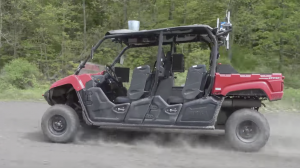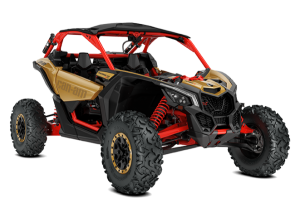
A frontal view of the aCar on test in Ghana,

The aCar was developed by the Technical University of Munich.
Technical University of Munich (TUM) scientists have introduced a prototype electric powered utility vehicle designed for use in rural Africa. Four years in development, the prototype is called aCar, as in “all-rounder”, and was developed specifically to meet the needs of sub-Saharan countries.
The aCar is a cross between a UTV and a small truck, and is off-road capable and can transport heavy loads with a total load capacity of 1 ton. The aCar has four-wheel drive and electric powered to minimize maintenance, provide plenty of torque and be environmentally friendly. The battery can also be used to power winch or as an energy source. The modular design for the rear of the vehicle provides versatility to carry cargo, passengers, a mobile physicians office, a water treatment solution or other functionality. Other key specifications and features include:
- 20 kW battery capacity
- 48-volt system
- 80 km range
- Top speed: 60 km/h
- 7 hour recharging time from 220 volt household socket
- Optional solar sheets
- Price: under 10,000 euros
- 3.7m x 1.5 m x 2.1 m
- Seating capacity: 2
- Simple production and low manufacturing costs
The vehicle was tested in Ghana for a month and was well received by locals. The aCar will first be produced in Europe to understand and optimize production, but the goal is to move production and eventually component manufacturing to Africa.
This project highlights some of the obstacles in creating a capable and affordable vehicle for customers in developing countries. Not only does such vehicle have to be affordable to purchase but also to operate. One might think that a large UTV manufacturer could just export their lower priced models. However, the complexity of the design, the need for a reliable fuel supply, and the additional cost of shipping the vehicle all create obstacles.
In terms of design, complexity invites potential for more breakdowns and requires a robust supply chain for parts and more technical expertise for repairs. A simple but robust design alleviates these issues. A leading UTV manufacturer would likely have to develop an entirely different platform for this market.
The modular approach for the aCar is different from the accessories and options approach in the UTV market. Developing modules for specific applications provides some flexibility but, in comparison to the UTV market, limits the level of customization that can be achieved. On the other hand, developing the modules and the requisite supply chain, is likely more cost effective than developing and supplying a wide range of accessories and options in areas where a dealer network will be very limited. A next step in this project may be to look at how the modular design approach can best balance cost, supply and complexity issues with vehicle customization to increase productivity and value.
Marc cesare, Smallvehicleresource.com












